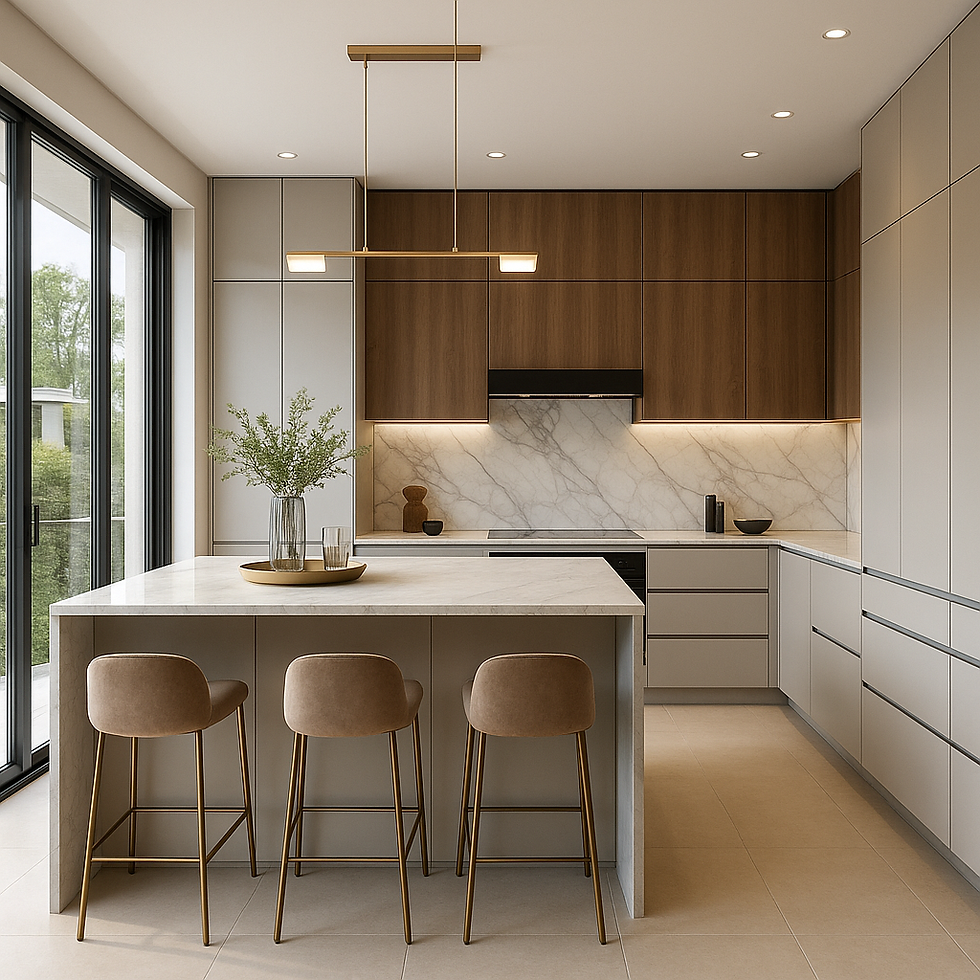Uncovering the Secrets of a Chic and Clutter-Free Kitchen: A Minimalist Approach
- Rogue Concepts
- Feb 14
- 4 min read
In today’s busy world, many people crave simplicity, leading them to embrace minimalism in their lives, including their kitchens. A well-crafted minimalist kitchen can inspire calmness and creativity, turning cooking into a joyful experience. By adopting minimalism, you not only eliminate clutter but also transform your kitchen into a stylish sanctuary that enhances your home life.
Minimalism focuses on valuing what truly matters and brings joy to your space. This post will explore actionable strategies to create a chic yet clutter-free kitchen, making your culinary area a peaceful center of your home.
Understanding Minimalism in the Kitchen
At the heart of minimalism is the idea that less is more. In the kitchen, this means reducing your tools, utensils, and decor to what is necessary and cherished. To cultivate a minimalist kitchen, start with an assessment of your cooking habits and identify the essentials.
Begin by evaluating your kitchen items. Ask yourself: Which tools do I use daily? What brings me joy? By differentiating between must-haves and sentimental pieces, you will create a kitchen that not only works efficiently but also feels right. For example, if you have five mixing bowls but only use one or two regularly, consider keeping just the ones you love.
The Essentials of a Luxe Kitchen
Minimalism can beautifully blend with luxury. A chic kitchen showcases valuable items rather than an array of possessions. Here are essential components to consider for achieving this balance:
Quality Over Quantity
Investing in high-quality cookware and appliances improves both performance and aesthetics. Instead of cluttering your kitchen with mediocre tools, select a few that shine in form and function. For instance, a high-quality chef's knife can cost about $100 but will last for years, making meal prep quicker and easier.
Color Palette
A simple, cohesive color palette creates a calmer atmosphere. Neutral tones such as whites, greys, and earth tones can make a space feel larger. Research shows that homes with lighter color schemes tend to feel more spacious. Consider darker cabinetry but pair it with light walls to keep your area elegant without feeling cramped.
Minimal Decor
In a minimalist kitchen, decor should be purposeful. A few striking pieces, such as a unique vase or a piece of wall art, serve as focal points. Adding plants can enliven the space while maintaining a clean look. Aim for open shelving to display a curated selection of attractive dishware or cookbooks, combining function with style.

Decluttering with Purpose
Removing unnecessary items is key to achieving a minimalist kitchen. This process can be liberating and allows you to create a space tailored to your needs.
Start Small
Tackling your kitchen one area at a time can make a big difference. Instead of trying to do it all at once, begin with one drawer or cabinet. Remove everything inside, clean the space, and evaluate each item—decide what to keep, donate, or toss. This method prevents you from feeling overwhelmed and helps you make quicker decisions.
Organize Strategically
After decluttering, it’s important to organize with intention. Use drawer dividers and baskets to group similar items. For example, keep all baking tools together and place cooking gadgets in another area. Having designated spots for everything makes it easier to maintain a tidy kitchen long-term.
Regular Maintenance
Commit to reassessing your kitchen items regularly. Scheduling monthly checks can help prevent the accumulation of unnecessary items. This mindfulness ensures that you only keep what adds value to your space and life.
Creating a Multi-Functional Space
A minimalist kitchen should not only be aesthetically pleasing but also highly functional. Designing a space that serves various purposes enhances both luxury and usability.
Incorporate Multi-Use Items
Choosing tools that have multiple functions can reduce clutter significantly. A good example is a food processor, which can chop, blend, and knead, offering great versatility without taking up much space. Another example is a stylish cutting board that doubles as a serving platter for entertaining guests.
Layout Matters
The layout of your kitchen greatly influences its functionality. Minimalist kitchens often feature an open design that connects cooking and entertaining areas seamlessly. This arrangement enhances movement and fosters interaction, making it a perfect spot for socializing.
Practical Tips for Sustaining Minimalism
Maintaining a minimalist kitchen is an ongoing journey. Here are some effective techniques to help keep your space chic and clutter-free:
Limit Your Purchases
Adopt a one-in-one-out approach when acquiring new kitchen items. For every new gadget, think about donating or discarding an old one. This strategy helps you avoid future clutter and ensures that every item you possess is intentional.
Embrace the Beauty of Empty Space
Don’t feel required to occupy every inch of your kitchen. Allowing empty space can create a more visually appealing environment. Embrace negative space to showcase the essentials you use every day, making your kitchen feel more expansive.
The Road to a Minimalist Culinary Haven
Mastering the art of minimalism in your kitchen results in a chic, calming, and luxurious environment. By focusing on quality, reducing clutter, and designing with purpose, you’ll cultivate a kitchen that enhances your cooking experience.
Take time to reflect on what you genuinely need and appreciate, allowing that to shape your decisions moving forward. With careful consideration and patience, you can create a kitchen that is both functional and a true reflection of your personal style.

With these strategies, you'll be well on your way to enjoying a sophisticated and serene cooking space that inspires creativity and joy every time you enter it.




Comments